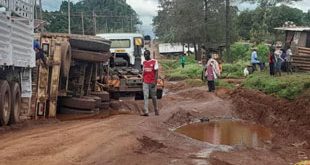
Some experts say the expansion in the local cement industry has been pegged onto public infrastructure projects like the Standard Gauge Railway and the oil infrastructure projects that are expected to take off soon. What risks do you anticipate shouldthese projects delay?
I think there is a misperception about these large projects. For example, if you look at last year when you had the Jinja Bridge, the Entebbe Expressway, the Karuma Dam and other large projects going up, the total cement consumption for these projects was around 10% of the total consumption in the country. So these projects are a plus when they come on board but they don’t change the dynamics of the industry. It is not because they are gone or that a few more are coming on board, that the industry will change completely— not at all. What makes the cement market in Uganda is the residential housing sector— which contributes 80% of the local demand. This is where our real market is. The large projects are nice but at the end of the day, it is you and your sister who are building small houses that contribute to the local cement demand much more than the large projects.
There was confusion early this year when amidst this expansion, cement scarcity hit the local market. What exactly went wrong?
It was an unfortunate event and if you look back, it lasted only a month. What happened in practice is rather simple. First, we as Hima, have our cement plant which has to undergo routine maintenance and that happens once a year. So we had our Kasese plant shut down for four weeks in February for maintenance. But as this happened, we believe, some of our competitors had some technical issues, so their production went down. The second cause (of scarcity) was that there were some imports coming from Kenya that were feeding the east and the northern markets and these imports stopped completely at the end of February and the beginning of March; reason being that the Kenyan market was rebounding. So they stopped exporting to Uganda around the same period. So the low production from the local players plus the stopping of imports from Kenya created this scarcity. However, the dynamic completely changed within a month when Tororo Cement, Hima Cement and National Cement, all started production. Now there is excess capacity.
What’s Hima Cement’s regional strategy for growing its market?
Our regional strategy goes a little bit beyond Him Cement. Hima Cement is part of the Lafarge-Holcim Group which is a global leader in building materials and we have assets all around eastern Africa. But when we look at Uganda, it is part of the network and our ambition is simple: We want to continue being number one in eastern Africa, just like in West Africa and North Africa—all over Africa. What the group is doing is looking at which market has the highest potential and definitely Uganda is a top priority. Uganda has a high population growth rate. People will need housing and highways in the future and so, there is a growth potential in the long term. Uganda will also soon become an oil producer which means that the country will get a new source of income which will boost growth. We therefore believe Uganda is among the countries that will be leading the construction industry. But also, politically Uganda is relatively stable, the ease of doing business is quite good though not perfect. On the regional strategy, we want to grow everywhere but we want to grow faster in Uganda. The DR Congo and South Sudan are good markets but they are quite volatile at the moment. However, if one day they stabilize, we believe Uganda is the perfect base to approach them.
What are some of the challenges you are still grappling with at Hima Cement?
The taxation regime is quite unfavorable to manufacturers and this is something that has got to be looked at. A simple example is that Hima pays Shs 10,000 per tonne of limestone in royalty yet we pay zero per cent in taxes if we import a tonne of clinker from the COMESA region. The second biggest challenge we are facing is electricity. The issue is not quantity of power—Uganda has enough power. The problem we have is quality of power. For example, just in September alone, our Kasese plant suffered 68 power outages which translated into 68 lost production hours. Our equipment keeps stopping all the time and it is not like your lights (at home) that you put on and off quite easily. Once the power goes off, even for two, three seconds, we need to go through a full cycle of restarting the equipment. So we lose approximately one hour every time we have an outage. If you do simple mathematics, we are losing between 10—15% of our production every month just because of power quality.That translates to millions of dollars every year.
What have you done about fixing this problem once and for all?
We have reached a point where we will have to invest in power generation near our plants. So we might not buy from the grid anymore, which is completely absurd. The other option is investing in Uninterruptible Power Source (UPS) system that would cover us for a few minutes in the event of outages so that the plant can benefit from stable power. But this is a multi-million dollar investment.
 The Independent Uganda: You get the Truth we Pay the Price
The Independent Uganda: You get the Truth we Pay the Price


